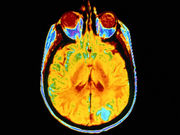Alterations in gray matter volume loss, thinning in association with major depressive disorder
THURSDAY, Dec. 17, 2015 (HealthDay News) — Early childhood depression is associated with cortical gray matter development in late school age and early adolescence, according to a study published online Dec. 16 in JAMA Psychiatry.
Joan L. Luby, M.D., from the Washington University School of Medicine in St. Louis, and colleagues examined the effects of early childhood depression on cortical gray matter development measured across three waves of neuroimaging. Data were collected for 193 children aged 3 to 6 years who were observed for up to 11 years in a longitudinal behavioral and neuroimaging study of childhood depression. Ninety of the children had a diagnosis of major depressive disorder.
The researchers found that 116 of the children had three full waves of neuroimaging scans. Marked alterations were seen in cortical gray matter volume loss (slope estimate, −0.93 cm³ per scan wave) and thinning (slope estimate, −0.0044 mm per scan wave) in association with experiencing a major depressive disorder episode prior to the first magnetic resonance imaging scan. There were no significant correlations observed between gray matter development and family history of depression or experiences of traumatic or stressful life events during this period.
“These findings underscore the significance of early childhood depression on alterations in neural development,” the authors write.
One author disclosed financial ties to the pharmaceutical industry. One author disclosed ties to the publishing industry.
Copyright © 2015 HealthDay. All rights reserved.








